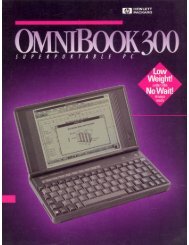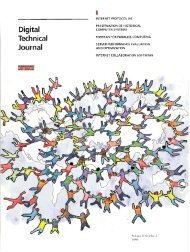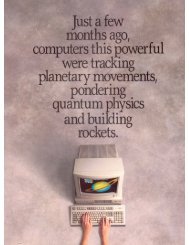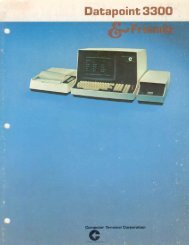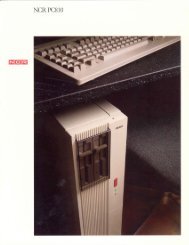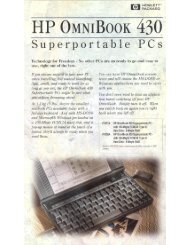Digital Technical Journal, Volume 5, Number 2 ... - 1000 BiT
Digital Technical Journal, Volume 5, Number 2 ... - 1000 BiT
Digital Technical Journal, Volume 5, Number 2 ... - 1000 BiT
Create successful ePaper yourself
Turn your PDF publications into a flip-book with our unique Google optimized e-Paper software.
MultimediaR = log,(q - 1)(4, - 1)'To completely specify this problem requires specifyingthe range for 4,. It is rcason;tble to do this byspecifying the number of bits 6 by which the imageinput values are to be represented. Specifying 6lilliits I\: to tlie rangeParameter 6 will be a key value in specitjling tlieresultin&. ' s y stem.Given the two expressions, (7) and (8), and thetwo unknowns. R and A:, a unique solution existsbecause tlie range of IY. is less than a factor of two.and R ant1 A$ are integers. To solve for R, substituteequation (6) for N, in equation (8). The res~~ltingequation islog - - 1) < R s l o( )(10)N" - I 4, - 1Since 2 I 4, 5 A:., the range of the expression inequation (10) must be less than one. Hence, give11that K is ;in integer,(*)IR = int [log24) - 1in equation (6) is now specified.As an example, consitler the case where 4,equals 87 (levels), 6 eqilals 9 (bits), 4 equnls 1,024(levels, for a 32-by-32 templ;ite). and IY. eqilals 256(levels). 'T'hus, R equals 2, ant1 the R-bit shifter dropsthe least-significant 2 bits. 4. equals 345 (levels);the tlither ;trrav is norni:~lizetl by equation (2) withA, = 1/256; and the gain factor to be incluclrd in themodified adjust LUT is 344/255. This data is loatledinto the system represented by Figure 4 i~ntl uni-formly ni;~ps input pixels ;tcross tlie 87 true outputlevels, giving the illusion of 256 levels.The output image that results from either of thedithering systems illustratetl in Figure 3 or Figure 4appears to contain more effective levels than areactu:~lly displayed. An effective level is either a perceivetlaverage level that is tlitheretl between twotrue oi~tlx~t levels or shades or an actual true outputlevel. k small nuniher of tenlplate levels 4 clictatesthe resulting number of effective levels. \Vhen4 js I;trge, the number of effective levels is equalto the number of input levels I\:, because it is notpossible to display more effective outputs thaninputs. [More precisely,Effective Levels = 1 (12)Note that Aa/N, in equation (12) is equal to A,/.When A , < 1, the normalization of the tlither array,i.e., equation (2), results in integer truncated valuesthat are not all unique. At this point, the number ofeffective levels saturates to N,.Data Width AnalysisThe design of an efficient dithering system, particularlyin hardware, depends on knowing the numberof bits recluired for all data paths in the system. Thissection presents an analysis of the one-memorydithering system shown in Figure 4.The system input 6, it., the bit depth of theimage input values, limits tlie data path for L,lx;y].The analysis shows the derivation of the precise bitdepths for the other dat;~ paths. In summary, tlietlerivation proves that the dither values in thedither matrix memory recluire R bits, where Rllll,, =(I? - I) and s = Li + d (and thus tlie R-bit shifter)require only 6 bits.Bits iVee~/e~/ fbr Dither iP1~1Lrin' The amount ofmemory needed to store the dither matrix is animport;~nt COIIC~~II; d,l,l,,,, denotes the maximumvalue. To determine dlll~,,, substitute the maximi~mvalue of T[x: y 'I, which is (IV, - l), into equation(2).'['he resulting equation isdl,,,,, which depends on iV,, thus has a value in therange1;or the case of ;I dither matrix with one value,namely A, = 1, equals the lower end of thisrange. dl,,,, equals the high encl of the range forlarge dither nlatrices, where 2R-' 5 N,. An iniportantobservation is that for all valiles in the range ofexpression (14), the number of bits needetl isex:tctly K.



